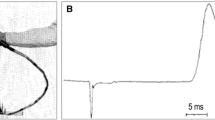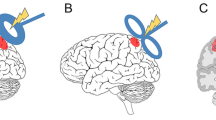Abstract
Twenty years ago, few scientists and clinicians could have imagined such a massive development in noninvasive brain stimulation—otherwise known as “NIBS”—as an innovative tool for neurophysiologic research, psychological and cognitive investigation, and, ultimately, clinical treatment of a wide spectrum of neuropsychiatric conditions. In fact, transcranial magnetic stimulation (TMS) and transcranial direct current stimulation (tDCS), the main NIBS techniques, have become the mainstay of translational neuroscience as research tools for understanding cognitive and behavioral states and their efficacy has been acknowledged within guideline-recommended algorithms for the treatment of different neurological conditions and psychiatric disorders.
Access provided by Autonomous University of Puebla. Download chapter PDF
Similar content being viewed by others
At the beginning of the millenium, not many neuroscientists and even less patient treating doctors could have predicted such a massive development in the field of noninvasive brain stimulation—otherwise known as “NIBS”—which became an innovative tool for neurophysiologic research, psychological and cognitive investigation, and, ultimately, clinical treatment of a wide spectrum of neuropsychiatric conditions. Indeed, transcranial magnetic stimulation (TMS) and transcranial direct current stimulation (tDCS)—the main NIBS techniques—have become the mainstay of translational neuroscience as research tools for understanding cognitive and behavioral states. In addition, their efficacy has been acknowledged within guideline-recommended algorithms for the treatment of different neurological conditions and psychiatric disorders [1,2,3].
There are many reasons regarding the unprecedented growth of preclinical and clinical investigation with NIBS techniques. One of these is represented by their accessibility and possibility to be associated with other research methodologies and clinical devices, including structural and functional neuroimaging, electroencephalography, genetics, and epigenetics investigation. This has permitted our increased understanding of the network activity underlying both healthy human brain functions as well as connectivity changes associated with dysfunctional states characterizing neuropsychiatric disorders.
On the other hand, as the acronym “NIBS” literally indicates, TMS and tDCS are considered safe and well-tolerated interventions for the investigation of neurophysiology, cognitive, affective, and other behavioral domains in healthy controls, as well as for the treatment of patients affected by different neuropsychiatric disorders. Indeed, the use of NIBS in neuroscience research not only allows us to investigate cortical excitability, cerebral connectivity, and neuroplasticity [4, 5] but, in relation to the clinical use of NIBS as therapeutic interventions, TMS and tDCS are considered by many clinicians and patients better tolerated than many psychotropic drugs, in light of their lack of systemic side-effects, including weight gain and sexual dysfunctions, which are often responsible for poor therapy compliance and treatment withdrawal in medicated patients. The favorable safety and tolerability profile of NIBS, however, is not to be claimed at the expense of the clinical efficacy of these interventions. For instance, since 2008, the American F.D.A. approved four different TMS devices for the treatment of Major Depressive Disorder with poor response to standard antidepressants. Lastly, NIBS techniques may also serve as adjuvants to support therapeutic activities across various disciplines, including re-learning or rehabilitative approaches, with encouraging results from field studies.
On this basis, the present book was conceived as a compendium of the latest acquisitions in the evolving field of NIBS, through the valuable contributions of a series of international experts in the areas of brain stimulation and neurophysiology, clinical psychology, neurology, and psychiatry. Across three sections, respectively, focused on (1) basic mechanisms of actions and rationale for the application of NIBS techniques in clinical neuroscience; (2) efficacy and safety of TMS; and (3) tDCS for the investigation and treatment of neuropsychiatric conditions and behavioral alterations, we sought to present a comprehensive and updated state of the art for NIBS in the aforementioned fields.
Because the unprecedented development of NIBS opened new ways for neuroscience by allowing researchers to validate their correlational theories through the direct manipulation of brain function for the first time [6], and for clinicians to safely approach difficult-to-treat conditions, we firmly believe that it deserves a place of priority in the modern education and wealth of knowledge of neuropsychiatrists, neurophysiologists, clinical psychologists, and other professionals involved in the study of neural mechanisms underlying emotions, cognition, and behavioral alterations.
Whether NIBS research in clinical neuroscience will contribute to the identification of biomarkers for specific diseases in the future still represents one of the greatest challenges; however, clinicians are currently focusing their efforts in identifying the best candidates and predictors of response to TMS and tDCS, optimizing stimulation parameters and anatomical targets. Notably, we have already been noticing the use of NIBS as therapeutic interventions for conditions that have been traditionally considered poor targets for psychotropic medications like, for instance, addictive behaviors and eating disorders with remarkable results [7].
Under these premises, we hope the present book will succeed in representing the uniqueness of NIBS as a translational research tool in clinical neuroscience through the peculiar capacity of TMS and tDCS to embrace different clinical and preclinical disciplines advancing their mutual understanding of brain functioning and alterations.
References
Lefaucheur JP, Antal A, Ayache SS, Benninger DH, Brunelin J, Cogiamanian F, Cotelli M, De Ridder D, Ferrucci R, Langguth B, Marangolo P, Mylius V, Nitsche MA, Padberg F, Palm U, Poulet E, Priori A, Rossi S, Schecklmann M, Vanneste S, Ziemann U, Garcia-Larrea L, Paulus W. Evidence-based guidelines on the therapeutic use of transcranial direct current stimulation (tDCS). Clin Neurophysiol. 2017;128(1):56–92s.
Lefaucheur JP, André-Obadia N, Antal A, Ayache SS, Baeken C, Benninger DH, Cantello RM, Cincotta M, de Carvalho M, De Ridder D, Devanne H, Di Lazzaro V, Filipović SR, Hummel FC, Jääskeläinen SK, Kimiskidis VK, Koch G, Langguth B, Nyffeler T, Oliviero A, Padberg F, Poulet E, Rossi S, Rossini PM, Rothwell JC, Schönfeldt-Lecuona C, Siebner HR, Slotema CW, Stagg CJ, Valls-Sole J, Ziemann U, Paulus W, Garcia-Larrea L. Evidence-based guidelines on the therapeutic use of repetitive transcranial magnetic stimulation (rTMS). Clin Neurophysiol. 2014;125(11):2150–206.
Milev RV, Giacobbe P, Kennedy SH, Blumberger DM, Daskalakis ZJ, Downar J, Modirrousta M, Patry S, Vila-Rodriguez F, Lam RW, MacQueen GM, Parikh SV, Ravindran AV, CANMAT Depression Work Group. Canadian Network for Mood and Anxiety Treatments (CANMAT) 2016 clinical guidelines for the management of adults with major depressive disorder: section 4. Neurostimulation treatments. Can J Psychiatr. 2016;61(9):561–75.
Di Lazzaro V, Rothwell J, Capogna M. Noninvasive stimulation of the human brain: activation of multiple cortical circuits. Neuroscientist. 2018;24(3):246–60.
Reinhart RM, Cosman JD, Fukuda K, Woodman GF. Using transcranial direct-current stimulation (tDCS) to understand cognitive processing. Atten Percept Psychophys. 2017;79(1):3–23.
Farzan F, Vernet M, Shafi MM, Rotenberg A, Daskalakis ZJ, Pascual-Leone A. Characterizing and modulating brain circuitry through transcranial magnetic stimulation combined with electroencephalography. Front Neural Circuits. 2016;10:73.
Yavari F, Shahbabaie A, Leite J, Carvalho S, Ekhtiari H, Fregni F. Noninvasive brain stimulation for addiction medicine: from monitoring to modulation. Prog Brain Res. 2016;224:371–99.
Author information
Authors and Affiliations
Corresponding author
Editor information
Editors and Affiliations
Rights and permissions
Copyright information
© 2020 Springer Nature Switzerland AG
About this chapter
Cite this chapter
Dell’Osso, B., Di Lorenzo, G. (2020). NIBS 2020: How TMS and tDCS Acquisitions Have Set New Standards in Clinical Neuroscience. In: Dell'Osso, B., Di Lorenzo, G. (eds) Non Invasive Brain Stimulation in Psychiatry and Clinical Neurosciences. Springer, Cham. https://doi.org/10.1007/978-3-030-43356-7_1
Download citation
DOI: https://doi.org/10.1007/978-3-030-43356-7_1
Published:
Publisher Name: Springer, Cham
Print ISBN: 978-3-030-43355-0
Online ISBN: 978-3-030-43356-7
eBook Packages: MedicineMedicine (R0)




